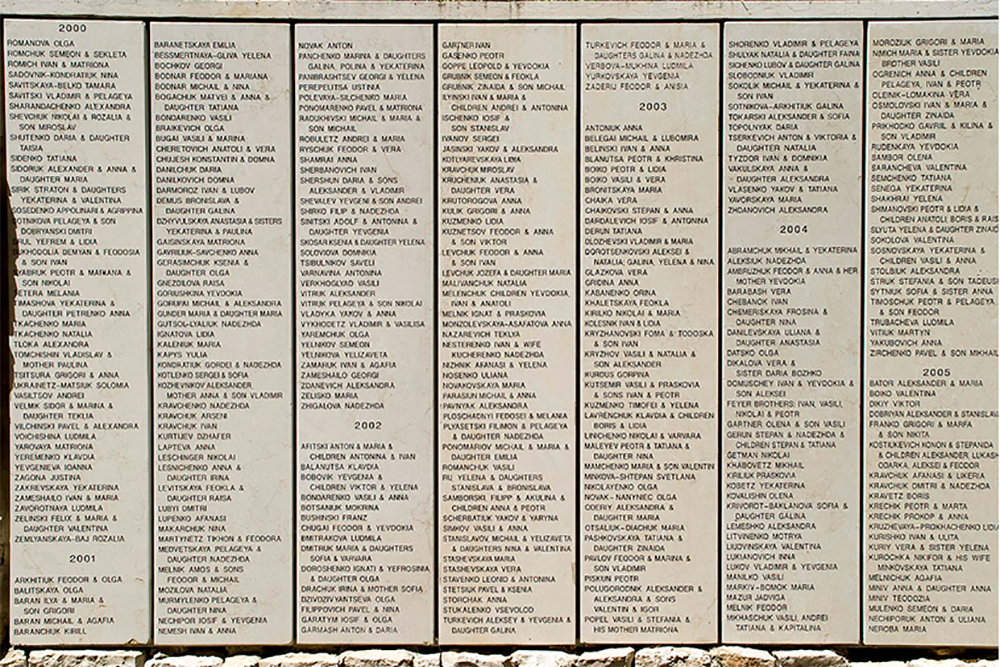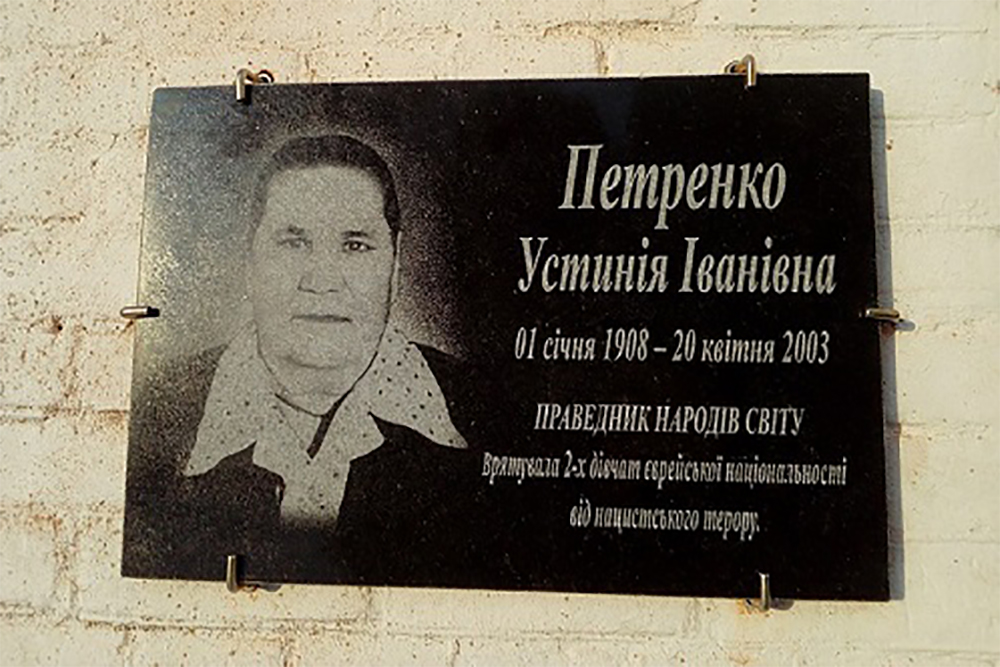Bank of Portraits / Petrenko Ustynia

Petrenko Ustynia
Ustynia Petrenko was born on September 15, 1908, in the village of Shatura (current Nizhyn district, Chernihiv region). Ivan and Maryna Petrenko had three other daughters: Melania, Ulyana and Yevdokia. As well as other village families, they lived thanks to their own land and farm. They had a horse and worked the land with it, as well as a cow, pigs and sheeps.
The girl used to work in agriculture from childhood. She studied with interest, but went to work after 7 forms at the local school. In 1927, the collective farm was established in Shatura. Ivan was employed there and later Ustynia joined him. In 1929, the entire Petrenko family worked in the newly established Blyukher Collective Farm. The women worked in the field while Ivan was a horseman. In the 1930s, Ustynia married fellow villager Mykhailo Petrenko. According to family memories, she was married in the local church. However, no church records of that time are preserved.
After the marriage, she lived in the husband’s family. Except the newlyweds, Mykhailo’s parents Savelii and Yevkhymia Petrenko and his brother Vasyl (born in 1922) lived in the small house. The young girl in love believed she began a new life. However, soon the endless hardship started, alongside losses and grief. In the Famine of the 1930s, her husband’s parents died, who loved her very much. Ustynia commemorated them, knowing little that the death would stay in their house for a long time. She took care of Vasyl like of her brother.
During her life in marriage, the woman gave birth to 7 children, 4 of whom died. It was very hard for Ustynia. She got weakened and aged, her hair got white. However, she did not lose faith that her children would live. In 1940, after the birth of a daughter, Mykhailo Petrenko died of heavy disease. Unstynia remained the young widow with three children. The war started…

“At one night in September 1941, someone knocked on the window of Ustynia. She responded and heard the familiar voices, opened the door and let them in. Those were two sisters, the daughters of the familiar Jewish woman Rakhil Medvedeva from Nizhyn. The girls’ names were Sonia and Vira…”. From the memories of the Petrenko family
It was necessary to save the Jews in the total conspiracy: there were many persons in the area who could inform the police. Facing mortal danger, the ordinary residents of Ukraine gave their helping hands. Many Ukrainians thought it was their human (or Christian) duty to shelter the innocent victims of hatred. Since the early days of the occupation, the new authorities set its rules of conduct and order of life for the local population. The “non-Arian” legal status of the Jews deprived them even the limited rights which the people from other nationalities had. The discrimination was in all the spheres of their lives.
During the war, sheltering the Jews, communists, Soviet officers was punished by death for saviors and rescued ones. However, Ustynia, risking herself and putting her little children under the risk, harbored the sisters. There were rumors in the village about the Jewish girls in one of the houses. When the village mayor Hryhorii came to the yard, Ustynia was scared, as she hid escapees on the stove under the rags and pillows. The sisters felt safe, but were afraid of searches. However, the mayor calmed Ustynia and suddenly offered assistance. They agreed that she would take black-haired Vira to work at the collective farm. Hryhorii promised: he would definitely warn in the case of any danger. And he kept his promises. The woman put the embroidered shirts on the girls. She covered their hair in the way that no faces were open fully. Sometimes, going to work in the field, she covered the girls’ faces with mud for masking. When any stranger came to the village as an inspector, the mayor informed Ustynia. Then the girls did not go outside or went out of the village at all, waiting in the forest belts. Later the mayor took the escapees to Ustynia again. Except the mayor, the German authorities appointed the policemen to the villages. In the village of Shatura they were the locals. Usually, the contemporaries recalled them badly. However, there were exceptions.
Not all the villagers knew that Ustynia Petrenko harbored the Jews. All people knew that she adopted the orphaned kids of the familiar woman. Probably, some people guessed that the girls were granddaughters of the Jew Yankel Berkov Bogrechevskyi, who lived in Shatura under the czar’s regime. Nina Dvorska told that her grandmother also sheltered the Jews. However, she was afraid of harboring them for a long time, as some of the villagers could inform the police. During the occupation, the village residents were cautious with the strangers. Some of them kept in secret that the Jewish girls were harbored and put themselves under risk as well. Others were afraid of speaking to Ustynia, because the police could notice it. However, most of the villagers had sympathy to the savior.
Vira (Dverta) Medvedeva, daughter of Solomon (Shlomo), was born in Nizhyn on November 4, 1923. By 1941, she graduated from 9 forms of the local secondary school No. 3. The Medvedev family returned to Nizhyn in 1937. They lived in Belarus for several years. In the 1930s, Vira, Sonia and Niusia lost their father and in 1941 lost their mother. Rakhil Medvedeva was shot dead by the perpetrators. The certain date of her death is unknown. It could happen either on November 6 during the mass executions of the Jews in Nizhyn or in September during the raids. Then the girls got to Shatura.
After the liberation of Nizhyn from the Nazis, Vira continued her education, worked as an accountant in the road exploitation directorate. In 1978 she retired. She did not break ties with her colleagues and ‘mother’ Ustynia, wrote them letters from the USA and supported the Petrenko family financially. Vira could not decide to move to America for a long time, delaying this decision, as she hoped Unstynia would go with her. The Jewish woman had a very strong connection to the Ukrainian who replaced her parents. However, the years passed, Sonia’s sister died, and all relatives of the Medvedev family migrated. In 1994, Vira took the decision. Being an elderly person, she did not want to be a burden for children and grandchildren of Ustynia and chose, probably, not the best, but quite rational option. Vira ans Sonia Medvedeva had a cousine, Vira Olkhovska. She also lived in Nizhyn and was unmarried, as well as the Medvedev sisters were. After migration to the USA, she stayed in touch with her sister. She often called her and asked about Ustynia. She told her about her life and good treatment.
Sofia (Sonia) Medvedeva was born in 1921 in Nizhyn. The date of her birth is unknown. Until 1941, the Medvedev family lived on 17 Pokrovska Street. In the lists of the street committees, the mother of Vira, Sonia and Niusia was registered under the number 133: Rakhil Medvedeva, housewife, born in 1895. The daughters were not registered there, as they lived not in Nizhyn, but in Shatura, when these lists were compiled. Sonia, contrary to Vira, had a ‘Slavic’ appearance, and did not risk so much to be caught by the Nazis as a Jew. However, according to witnesses’ testimonies, she got under the raid and was deported to Germany as a forced worker.
After the release, Sonia volunteered to the Red Army. She returned to Nizhyn and worked as an accountant at the boarding school for disabled children. She died in 1984 and was buried in Nizhyn.
Sister Niusia, as well as Vira, lived in the United States of America.
Ustynia Petrenko was recognized as the Righteous Among the Nations on March 22, 1998.

Tetiana Ruban
Shatura village, Chernihiv region
Shatura secondary school
-
fingerprintArtefacts
-
theatersVideo
-
subjectLibrary

